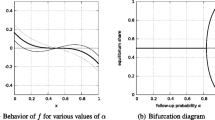Abstract
An evolutionary approach to the problem of economic mechanism choice is presented. It demonstrates the power that a single participant has on the choice of a preferred market mechanism. A population of sellers, each with one of two possible economic mechanisms, facing potential buyers, is presented as a test model. It is shown that if two auctions, such as first- and second-price auctions, are to attract an identical number of buyers, although under the model assumptions their expected revenues are identical, sellers using a first-price auction mechanism will be selected for. However, if a second-price auction attracts one additional buyer, then it will be selected for by the evolutionary process. These results are extended to the choice between an arbitrary k- and l-price auctions.
Similar content being viewed by others
References
A. Bergman and M. W. Feldman, “On the evolution of learning: Representation of a stochastic environment,” Theoretical Population Biology, vol. 48, pp. 251-276, 1995.
C. Boutilier, Y. Shoham, and M. P. Wellman, “Special issue on economic principles of multi-agent systems.” Artificial Intelligence, vol. 94, 1997.
J. Bulow and P. Klemperer, “Auctions versus negotiations,” American Economic Review, vol. 86, no. 1, pp. 180-194, 1996.
R. A. Fisher, The Genetical Theory of Natural Selection, Dover: New York, NY, 1958.
D. Fudenberg and J. Tirole, Game Theory, MIT Press: Cambridge, MA, 1991.
J. Gillespie, “Polymorphism in random environments,” Theoretical Population Biology, vol. 4, pp. 193-195, 1973.
D. L. Hartl and R. D. Cook, “Balanced polymorphisms of quasineutral alleles,” Theoretical Population Biology, vol. 4, pp. 163-172, 1973.
S. Hon-Snir, D. Monderer, and A. Sela, “A leaning approach to auctions,” Journal of Economic Theory, vol. 82, pp. 65-88, 1998.
J. H. Kagel, “Auctions: A survey of experimental research,” in J. H. Kagel and E. A. Roth (eds.), The Handbook of Experimental Economics, vol. 1571. Princeton University Press, New Jersey, 1995.
S. Karlin and U. Liberman, “Random temporal variation in selection intensities: Case of large population size,” Theoretical Population Biology, vol. 6, pp. 355-382, 1974.
D. Fudenberg and D. Levine, The Theory of Learning in Games, MIT Press: Cambridge, MA, 1998.
P. R. Milgrom, “Auction theory,” in T. Bewly (ed.), Advances in Economic Theory: Fifth World Congress, Cambridge University Press, Cambridge, England, 1987, pp. 1-32.
D. Monderer, M. Tennenholtz, and H. Varian, “Game theory and artificial intelligence,” Special issue of Games and Economic Behavior, vol. 35, 2001.
Dov Monderer and Moshe Tennenholtz, “Asymptotically optimal multi-object auctions for riskaverse agents,” Working paper, Technion, Israel, 2000.
A. E. Roth and I. Erev, “Experimental data and simple dynamics models in the intermediate term,” Nobel Symposium on Game Theory, Bjorkborn, Sweden, 1993.
T. Sandholm, “Agents in electronic commerce: Component technologies for automated negotiation and coalition formation,” in M. Klusch (ed.), Cooperative Information Agents, Lecture Notes in Artificial Intelligence, Springer Verlag, Berlin, Heidelberg, New York, 1998, vol. 1571, pp. 113-134.
M. Tennenholtz, “Electronic commerce: From game-theoretic and economic models to working protocols,” in IJCAI-99, 1999.
R. Wilson, “Strategic analysis of auctions,” in R. J. Aumann and S. Hart (eds.), Handbook of Game Theory, vol. 1, Elsevier Science Publisher, 1992.
E. Wolfstetter, “Auctions: An introduction,” Journal of Economic Surveys, vol. 10, no. 4, pp. 367-420, 1996.
Author information
Authors and Affiliations
Rights and permissions
About this article
Cite this article
Bergman, A., Tennenholtz, M. On the Natural Selection of Market Choice. Autonomous Agents and Multi-Agent Systems 5, 387–395 (2002). https://doi.org/10.1023/A:1019610610779
Issue Date:
DOI: https://doi.org/10.1023/A:1019610610779




